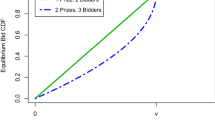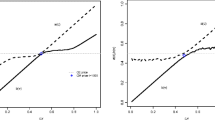Abstract
In this paper, we study an agent-based model for multi-round, pay as bid, sealed bid reverse auctions using techniques from partial differential equations and statistical mechanics tools. We assume that in each round a fixed fraction of bidders is awarded, and bidders learn from round to round using simple microscopic rules, adjusting myopically their bid according to their performance. Agent-based simulations show that bidders coordinate in the sense that they tend to bid the same value in the long-time limit. Moreover, this common value is the true cost or the ceiling price of the auction, depending on the level of competition. A discontinuous phase transition occurs when half of the bidders win. We establish the corresponding rate equations, and we obtain a system of ordinary differential equations describing the dynamics. Finally, we derive formally the kinetic equations modeling the dynamics, and we study the asymptotic behavior of solutions of the corresponding first-order, nonlinear partial differential equation satisfied by the distribution of agents.








Similar content being viewed by others
Data Availability
No data is associated to this work.
References
Aceves-Sánchez P, Bostan M, Carrillo JA, Degond P (2019) Hydrodynamic limits for kinetic flocking models of Cucker–Smale type. Math Biosci Eng 16:7883–7910
Ackleh AS, Cleveland J (2013) Evolutionary game theory on measure spaces: well-posedness. Nonlinear Anal Real World Appl 14(1):785–797
Ackleh AS, Cleveland J, Thieme H (2016) Population dynamics under selection and mutation: long-time behavior for differential equations in measure spaces. J Differ Equ 261(2):1472–1505
Ackleh AS, Saintier N (2020) Well-posedness for a system of transport and diffusion equations in measure spaces. J Math Anal Appl 492(1):124397
Ackleh AS, Saintier N, Skrzeczkowski J (2020) Sensitivity equations for measure-valued solutions to transport equations. Math Biosci Eng 17(1):514–537
Albi G, Bellomo N, Fermo L, Ha SY, Kim J, Pareschi L, Poyato D, Soler J (2019) Vehicular traffic, crowds, and swarms: from kinetic theory and multiscale methods to applications and research perspectives. Math Models Methods Appl Sci 29:1901–2005
Anatolitis V (2020) AURES, auctions for the support of renewable energy in Greece, Report D2.1-EL, February
Anatolitis V, Grundlach P (2020) AURES, auctions for the support of renewable energy in Ukraine, Report D2.2-UA, October 2020
Anatolitis V, Welisch W (2017) Putting renewable energy auctions into action—an agent-based model of onshore wind power auctions in Germany. Energy Policy 110:394–402
Boccabella A, Natalini R, Pareschi L (2011) On a continuous mixed strategies model for evolutionary game theory. Kinetic Relat Models 4:187–213
Bulow JI, Klemperer P (1993) Auctions vs. negotiations. Available at SSRN: https://ssrn.com/abstract=5866 or 10.2139/ssrn.5866
Castellano C, Fortunato S, Loreto V (2009) Statistical physics of social dynamics. Rev Mod Phys 81:591
Cercignani C, Illner R, Pulvirenti M (1994) The mathematical theory of dilute gases. Springer series in applied mathematical sciences. Springer, Berlin, p 106
Chakrabarti BK, Chakraborti A, Chakravarty SR, Chatterjee A (2013) Econophysics of income and wealth distributions. Cambridge University Press, Cambridge
Coddington EA, Levinson N (1955) Theory of ordinary differential equations. Tata McGraw-Hill Education, New York
Embrechts P, Hofert M (2013) A note on generalized inverses. Math Methods Oper Res 77:423–432
German official statistics concerning the German wind on-shore auctions available freely at https://www.bundesnetzagentur.de/DE/Sachgebiete/ElektrizitaetundGas/Unternehmen_Institutionen/Ausschreibungen/Wind_Onshore/BeendeteAusschreibungen/BeendeteAusschreibungen_node.html
Giambiagi Ferrari C, Pinasco JP, Saintier N (2020) Coupling epidemiological models with social dynamics. Bull Math Biol 83:73
Kácsor E (2021) Modelling bidding behaviour on German photovoltaic auctions. Energies 14:516
Klemperer P, Binmore K (2002) The biggest auction ever: the sale of the British 3G telecom licences. Econ J 112:C74–C96
Klemperer P (2004) Auctions: theory and practice. Princeton University Press, Princeton
Krishna V (2009) Auction theory. Academic Press, Cambridge
Lundberg L (2019) Auctions for all? Reviewing the German wind power auctions in 2017. Energy Policy 128:449–458
Machado MR, Fujii MK, de Oliveira Ribeiro C, Rego EE (2019) An agent-based model applied to Brazilian wind energy auctions. IEEE Latin Am Trans 17(05):865–874
Menezes FM, Monteiro PK (2005) An introduction to auction theory. Oxford University Press, Oxford
Milgrom P (2004) Putting auction theory to work. Cambridge University Press, Cambridge
Nedelec T, Calauzènes C, Karoui NE, Perchet V (2020) Learning in repeated auctions. arXiv preprint arXiv:2011.09365
Pareschi L, Toscani G (2013) Interacting multiagent systems: kinetic equations and Monte Carlo methods. OUP, Oxford
Perez-Llanos M, Pinasco JP, Saintier N, Silva A (2018) Opinion formation models with heterogeneous Persuasion and Zealotry. SIAM J Math Anal 50:4812–4837
Pinasco JP, Rodriguez Cartabia M, Saintier N (2018) A game theoretic model of wealth distribution. Dyn Games Appl 8(4):874–890
Pinasco JP, Rodriguez-Cartabia M, Saintier N (2021) Evolutionary game theory in mixed strategies: from microscopic interactions to kinetic equations. Kinetic Relat Models 14:115–148
Saintier N, Marenco J, Kind M, Pinasco JP, Competition level as a key parameter in well-structured renewable energy auctions, submitted
Sen P, Chakrabarti BK (2014) Sociophysics: an introduction. Oxford University Press, Oxford
Szabó L, Bartek-Lesi M, Dézsi B, Diallo A, Mezösi A (2020) Auctions for the support of renewable energy: lessons learnt from international experiences—synthesis report of the AURES II case studies
Tembine H (2009) Population games with networking applications. Université d’Avignon. https://tel.archives-ouvertes.fr/tel-00451970/document
Toscani G (2006) Kinetic models of opinion formations. Commun Math Sci 4(3):481–496
Villani C (2003) Topics in optimal transportation. Graduate studies in mathematics (58). American Mathematical Society, Providence
Welisch MG (2018) Auctions for renewable energy in Europe model based analysis and beyond. Doctoral dissertation, Wien
Author information
Authors and Affiliations
Contributions
All the authors contributed on the conceptualization and analysis of the problem; and writing, reviewing and editing of the manuscript; NS and JPP contributed on the design of the computational simulations, and the derivation of the theoretical results.
Corresponding author
Ethics declarations
Conflict of interest
The authors declare that they have no known competing financial interests or personal relationships that could influence the results reported in this paper.
Additional information
Publisher's Note
Springer Nature remains neutral with regard to jurisdictional claims in published maps and institutional affiliations.
This article is part of the topical collection “Learning and Computations in Games and Economics” edited by Mehryar Mohri and Vianney Perchet.
Appendix
Appendix
Proposition 8
When \(f_0 = 1\) in [0, 1], the solution of (5.6) is given by
-
if \(p\le \frac{1}{4}\):
$$\begin{aligned} f_t = {\left\{ \begin{array}{ll} 1_{[t,1-t]} + 2t\delta _{a(t)}, \\ \qquad a(t)=p &{}\quad 0\le t\le p \\ 1_{[a(t),1-t]} + 2\sqrt{pt}\delta _{a(t)}, \\ \qquad a(t)=2\sqrt{pt}-t, &{}\quad p\le t\le T:=4p. \end{array}\right. } \end{aligned}$$ -
if \(\frac{1}{4}< p<\frac{1}{2}\):
$$\begin{aligned} f_t = {\left\{ \begin{array}{ll} 1_{[t,1-t]} + 2t\delta _{a(t)}, \\ \qquad a(t)=p &{}\quad 0\le t\le p \\ 1_{[a(t),1-t]} + (t+a(t))\delta _{a(t)}, \\ \qquad a(t)=2\sqrt{pt}-t, &{}\quad p\le t\le \frac{1}{4p}, \\ \delta _{a(t)}, \\ \qquad a(t)=(2p-1)(t-\frac{1}{4p}) + 1-\frac{1}{4p}, &{} \quad \frac{1}{4p}\le t\le T:=\frac{1}{2(1-2p)}. \end{array}\right. } \end{aligned}$$ -
if \(p=\frac{1}{2}\):
$$\begin{aligned} f_t = {\left\{ \begin{array}{ll} 1_{[t,1-t]} + 2t\delta _{a(t)}, \\ \qquad a(t)=p &{}\quad 0\le t\le \frac{1}{2} \\ \delta _{a(t)}, \\ \qquad a(t)=\frac{1}{2} &{}\quad t\ge \frac{1}{2} \end{array}\right. } \end{aligned}$$ -
if \(\frac{1}{2}\le p\le \frac{3}{4}\):
$$\begin{aligned} f_t = {\left\{ \begin{array}{ll} 1_{[t,1-t]} + 2t\delta _{a(t)}, \\ \qquad a(t)=1-p &{}\quad 0\le t\le 1-p \\ 1_{[t, a(t)]} + 2\sqrt{(1-p)t} \delta _{a(t)}, \\ \qquad a(t)=1-2\sqrt{(1-p)t}+t, &{}\quad 1-p\le t\le \frac{1}{4(1-p)}, \\ \delta _{a(t)}, \\ \qquad a(t)=-(1-2p)(t-\frac{1}{4(1-p)}) + \frac{1}{4(1-p)}, &{}\quad \frac{1}{4(1-p)}\le t\le T:=\frac{1}{2(2p-1)}. \end{array}\right. } \end{aligned}$$ -
if \(\frac{3}{4}\le p\le 1\):
$$\begin{aligned} f_t = {\left\{ \begin{array}{ll} 1_{[t,1-t]} + 2t\delta _{a(t)}, \\ \qquad a(t)=p &{}\quad 0\le t\le 1-p \\ 1_{[t, a(t)]} + 2\sqrt{(1-p)t}\delta _{a(t)}, \\ \qquad a(t)=1-2\sqrt{(1-p)t}+t, &{}\quad 1-p\le t\le T:=4(1-p). \end{array}\right. } \end{aligned}$$
The proof is a direct verification that \(f_t\) solves (5.4) with \(\sigma =0\). First notice that for any t, \(F_t^{-1}(p)=a(t)\) so that
For \(0\le t\le p\), \(\langle f_t,\phi \rangle =\int _t^{1-t}\phi + 2t \phi (p)\) so that
On the other hand, notice that \(P_0[f_t](p)=\frac{1}{2}\) so that the right-hand side of (5.4) is
This computation holds until there is no more mass on at least one side of \(\delta _{a(t)}\). When \(p\le \frac{1}{2}\) (resp. \(p\ge \frac{1}{2}\)), this holds when \(1_{[t,p]}\) (resp. \(1_{[p,1-t]}\)) collapses to \(\delta _p\) which occurs at time \(t=p\) (resp. \(t=1-p\)).
Let us examine first the case \(p\le \frac{1}{2}\). For \(t\ge p\), we look for a solution of the form \(f_t = 1_{[a(t),1-t]} + (t+a(t))\delta _{a(t)}\). Then \(\langle f_t,\phi \rangle =\int _{a(t)}^{1-t} \phi + (t+a(t))\phi (a(t))\) so that
On the other hand, with \(P_0[f_t](a(t))=\frac{p}{t+a(t)}\), the right-hand side of (5.4) is
Equating these two expressions, we see we must choose a satisfying \(a'(t)=\frac{2p}{t+a(t)}-1\), \(t>p\), with \(a(p)=p\). Solving we obtain \(a(t)=2\sqrt{pt}-t\). This computation holds until \(1_{[a(t),1-t]}\) collapses to \(\delta _{a(t)}\), i.e., \(1-t=a(t)\) if and only if \(t=\frac{1}{4p}\), or \(a(t)=0\) if and only if \(t=4p\), whatever occurs first. If \(\frac{1}{4}<p<\frac{1}{2}\), then \(1_{[a(t),1-t]}\) collapses to \(\delta _{a(t)}\) before reaching 0. Then from \(t\ge \frac{1}{4p}\), \(f_t\) is a Dirac mass \(\delta _{a(t)}\), and we can use Proposition 3, for \(a'(t)=2p-1\). This holds until \(a(t)=0\) which occurs at \(t=\frac{1}{2p(1-2p)}\).
If \(p\ge \frac{1}{2}\), the result follows from the case \(p\le \frac{1}{2}\) and Proposition 5.
Rights and permissions
Springer Nature or its licensor (e.g. a society or other partner) holds exclusive rights to this article under a publishing agreement with the author(s) or other rightsholder(s); author self-archiving of the accepted manuscript version of this article is solely governed by the terms of such publishing agreement and applicable law.
About this article
Cite this article
Pinasco, J.P., Saintier, N. & Kind, M. Learning, Mean Field Approximations, and Phase Transitions in Auction Models. Dyn Games Appl 14, 396–427 (2024). https://doi.org/10.1007/s13235-023-00508-9
Accepted:
Published:
Issue Date:
DOI: https://doi.org/10.1007/s13235-023-00508-9




